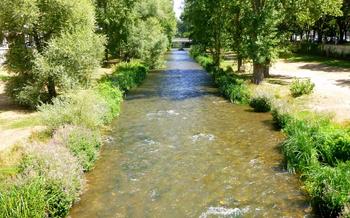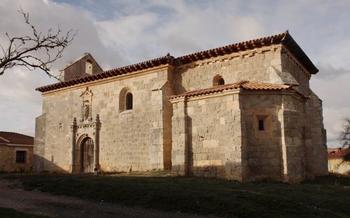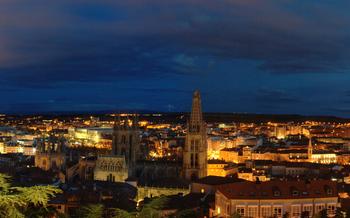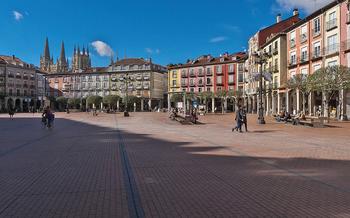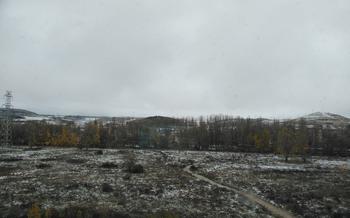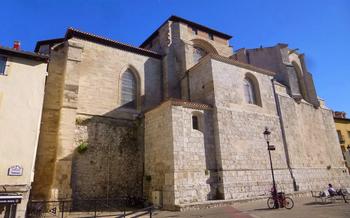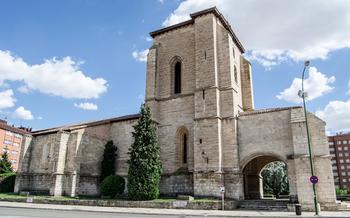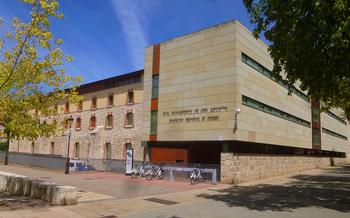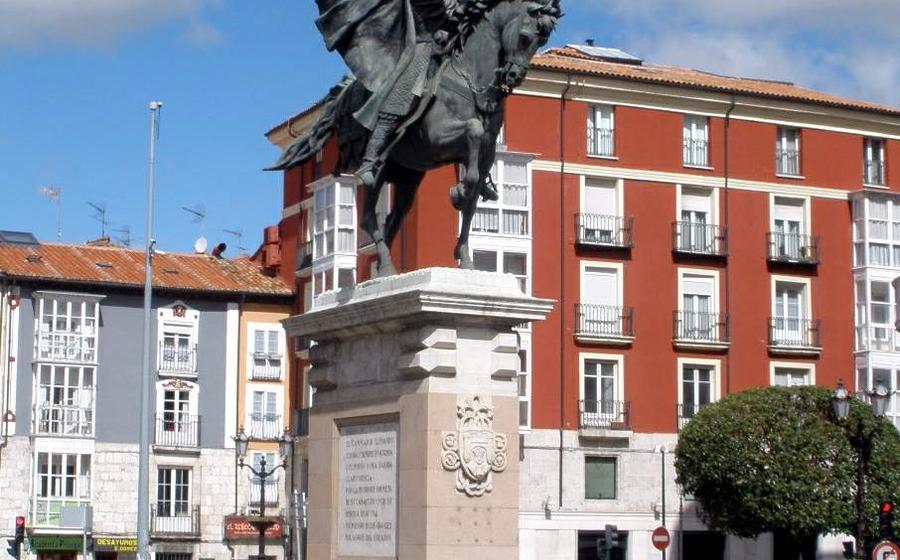
Plaza del Mío Cid
- Burgos Cathedral
- Plaza Mayor
- A lively square in the heart of Burgos
- Mirador del Castillo
- Monastery of San Pedro de Cardeña
- Museum of Human Evolution
- Atapuerca Archaeological Sites
- Sierra de la Demanda
- Oña
- Covarrubias
- Santo Domingo de Silos Monastery
- Salas de los Infantes
- Poza de la Sal
- Lerma
- Insider Tip
Burgos Cathedral
Burgos Cathedral, a UNESCO World Heritage Site, is an awe-inspiring masterpiece of Gothic architecture, towering over the city's historic center. Its construction began in the 13th century and spanned over 200 years, resulting in a harmonious blend of Gothic elements with influences from Romanesque, Renaissance, and Baroque styles. The cathedral's most striking features include its magnificent spires, intricate carvings, and stunning stained-glass windows.
The interior of the cathedral is equally impressive, boasting a vast nave, elegant chapels, and a breathtaking altarpiece. The Capilla del Condestable, with its elaborate Renaissance carvings, is a highlight, while the Capilla Mayor, adorned with intricate Gothic tracery, houses the remains of El Cid, the legendary Castilian knight.
Plaza Mayor
A lively square in the heart of Burgos
The Plaza Mayor is the heart of Burgos, a lively square surrounded by arcades and buildings that date back to the Middle Ages. The square was built in the 15th century and was once used as a market place. Today, it is a popular spot for locals and tourists alike, who come to enjoy the many bars, restaurants, and shops.
The square's most striking feature is its arcades, which are supported by slender columns. The arcades provide shade from the sun and rain, and they also create a unique and charming atmosphere. The buildings that surround the square are a mix of architectural styles, from the Gothic to the Renaissance.
The most important building in the Plaza Mayor is the City Hall, which was built in the 16th century. The City Hall is a beautiful example of Renaissance architecture, and it is home to the city's government. Another important building in the square is the Casa del Cordón, which was built in the 15th century. The Casa del Cordón is a former palace that is now used as a museum.
The Plaza Mayor is a great place to people-watch and soak up the atmosphere of Burgos. It is also a great place to start your exploration of the city.
Mirador del Castillo
The Mirador del Castillo, or Castle viewpoint, offers a breathtaking panorama of the city of Burgos and its surrounding countryside. Situated upon a hill overlooking the city, it was built in the 10th century as part of the city's fortifications. The viewpoint is easily accessible on foot from the city center and offers a stunning perspective of the city's most iconic landmarks, including the Burgos Cathedral.
From the viewpoint, visitors can admire the cathedral's soaring spires and intricate facade, the winding streets of the old city, and the lush green hills of the surrounding countryside. The viewpoint also offers a glimpse into the city's rich history, as the remains of the castle walls and towers can still be seen nearby.
The Mirador del Castillo is a popular spot for both locals and tourists, and is particularly beautiful at sunset when the sky is ablaze with color. It's a perfect place to relax and soak in the beauty of Burgos, making it a must-visit for anyone exploring this historic city.
Monastery of San Pedro de Cardeña
Location and history: Situated a short distance from the city of Burgos, the Monastery of San Pedro de Cardeña stands as a testament to the rich history and religious heritage of the region. Founded in the 9th century, the monastery has undergone several transformations over the centuries, reflecting the changing architectural styles and evolving spiritual practices of the time. Initially established as a Benedictine monastery, it later became a Cistercian abbey, leaving a lasting imprint on its architectural features and monastic traditions.
Architecture and art: The monastery's architectural style is a blend of Romanesque and Gothic elements, showcasing the transition between these two distinct periods. Its imposing facade boasts a Romanesque doorway with intricate carvings, while the interior reveals a Gothic cloister with graceful arches and delicate tracery. Among the monastery's artistic treasures are the beautifully preserved frescoes adorning the walls of the cloister, depicting scenes from the life of Christ and the saints.
Link to El Cid: The Monastery of San Pedro de Cardeña holds a special significance in Spanish history and literature as it is closely associated with the legendary figure of El Cid, the renowned medieval warrior and hero. According to legend, El Cid spent his final days at the monastery and was eventually buried within its walls. Visitors can pay homage to El Cid's memory by visiting his tomb, which is located in the monastery's church.
Importance as a pilgrimage site: The monastery's religious significance extends beyond its historical connection to El Cid. Throughout the centuries, it has served as an important pilgrimage site, attracting devout pilgrims from across the region. The monastery's reputation for spirituality and its association with El Cid have made it a popular destination for those seeking spiritual guidance and inspiration.
Museum of Human Evolution
On the outskirts of Burgos, the Museum of Human Evolution offers a fascinating journey through the history of human evolution. Founded in 2010, the museum houses an extensive collection of fossils, interactive exhibits, and educational displays that trace the development of our species from its earliest origins to the present day.
The museum's exhibits are organized into four main sections: The Origins of Life, The Evolution of Primates, The Emergence of Humans, and The Modern Human Era. Visitors can explore each section at their own pace, using interactive displays, touchscreens, and multimedia presentations to learn about the latest scientific discoveries in human evolution.
One of the highlights of the museum is the Hall of Human Origins, which features a stunning collection of fossils from our earliest ancestors, including Australopithecus afarensis, Homo habilis, and Homo erectus. Visitors can also learn about the evolution of bipedalism, the development of stone tools, and the emergence of language.
Another must-see exhibit is the Hall of Neanderthals, which explores the lives and culture of our closest extinct relatives. Here, visitors can examine Neanderthal fossils, learn about their hunting and gathering strategies, and see how they adapted to the challenges of the Ice Age.
The Museum of Human Evolution is a must-visit for anyone interested in learning more about the history of our species. With its engaging exhibits, interactive displays, and educational programs, the museum offers a truly immersive experience that will leave you with a newfound appreciation for the wonders of human evolution.
Atapuerca Archaeological Sites
Location and history of the sites
The Atapuerca Archaeological Sites are located in the Sierra de Atapuerca, a mountain range in the province of Burgos, Spain. The sites consist of a number of caves and rock shelters that have been occupied by humans for over a million years. The most famous of these sites is the Gran Dolina, which has yielded the remains of some of the earliest known hominids in Europe.
The sites' importance for understanding human evolution
The Atapuerca sites have been instrumental in our understanding of human evolution. The remains found at the sites have helped to shed light on the origins of our species and the evolution of our ancestors. The sites have also provided evidence of the presence of Neanderthals and Denisovans in Europe, and have helped to clarify the relationship between these groups and modern humans.
The remains of early hominids found at the sites
The Atapuerca sites have yielded the remains of a number of early hominids, including Homo antecessor, Homo heidelbergensis, and Neanderthals. The most famous of these discoveries is the skull of Miguelón, which is the oldest known complete skull of a hominid in Europe. The skull is estimated to be over 2 million years old, and it provides important insights into the evolution of our species.
The sites' designation as a UNESCO World Heritage Site
In 2000, the Atapuerca Archaeological Sites were designated a UNESCO World Heritage Site. This designation recognizes the sites' outstanding universal value and their importance for understanding human evolution. The sites are one of the most important archaeological sites in the world, and they continue to be a source of new discoveries that are helping to shed light on our past.
Sierra de la Demanda
The Sierra de la Demanda is a mountain range located in the south of the province of Burgos, in the autonomous community of Castile and León, Spain. It is part of the Iberian System and is the highest mountain range in the province, with peaks reaching over 2,000 meters above sea level. The Sierra de la Demanda is a popular destination for outdoor activities such as hiking, mountain biking, and skiing.
The Sierra de la Demanda is home to a wide variety of plant and animal life. The forests are home to a variety of trees, including oaks, pines, and beeches. The mountains are also home to a variety of animals, including deer, wild boar, and wolves. The Sierra de la Demanda is also a popular destination for birdwatching, as it is home to a variety of birds, including eagles, vultures, and hawks.
The Sierra de la Demanda is a beautiful and rugged mountain range that offers a variety of outdoor activities for visitors of all ages. Whether you are looking for a challenging hike or a relaxing walk in the woods, the Sierra de la Demanda has something to offer everyone.
Oña
Oña is a town in the province of Burgos, in the autonomous community of Castile and León, Spain. It is located in the foothills of the Sierra de la Demanda, on the banks of the Oca River.
The town was founded in the 10th century by Sancho García, the first Count of Castile. It quickly became an important centre of the region, and was the capital of the County of Castile until the 13th century.
Oña is home to a number of medieval buildings, including the Colegiata de Santa María la Mayor, a Romanesque church that was built in the 11th and 12th centuries. The church is home to a number of important works of art, including the Oña Codex, a 12th-century manuscript that is one of the most important examples of Spanish Romanesque illumination.
Oña is also an important religious centre. It is home to the Benedictine Abbey of San Salvador de Oña, which was founded in the 10th century. The abbey is one of the oldest and most important Benedictine monasteries in Spain.
Every year, Oña hosts a pilgrimage to the shrine of the Virgen de Oña, which is held on the 8th of September. The pilgrimage is one of the most important religious events in the region.
Covarrubias
Lying amidst the picturesque landscapes of the Arlanza River Valley, Covarrubias, a captivating medieval town, exudes an irresistible charm that draws visitors from far and wide. Its rich history, deeply intertwined with the fabled Camino de Santiago pilgrimage route, adds to its allure, making it a must-visit destination for pilgrims and history enthusiasts alike.
The town's architectural heritage is a testament to its glorious past. Admire the intricate details of the 10th-century collegiate church of San Cosme y San Damián, a masterpiece of Romanesque architecture. Stroll along the cobbled streets, where centuries-old stone houses line the way, their facades adorned with Gothic and Renaissance elements.
Covarrubias's connection to the Camino de Santiago, a renowned pilgrimage route, has played a significant role in shaping its identity. The town served as a welcoming haven for weary pilgrims, offering them respite and spiritual sustenance as they journeyed towards the holy city of Santiago de Compostela.
To immerse yourself in the town's vibrant past, plan your visit during its annual medieval market, held every July. This lively event transports visitors back in time, as locals and artisans don period costumes, transforming the town into a bustling marketplace reminiscent of bygone eras.
Whether you're a history buff, a pilgrim seeking solace, or simply a traveler yearning for authentic experiences, Covarrubias beckons with its timeless charm and captivating medieval allure.
Santo Domingo de Silos Monastery
The Santo Domingo de Silos Monastery is a Benedictine monastery located in the town of Silos, in the province of Burgos, Spain. It is one of the most important Romanesque monasteries in Spain and is known for its beautiful cloister and its Gregorian chant choir.
The monastery was founded in the 10th century and was rebuilt in the 12th century. The Romanesque church was built in the 12th and 13th centuries and is a masterpiece of Romanesque architecture. The church has a beautiful apse with five radiating chapels and a transept with two towers. The cloister, built in the 12th and 13th centuries, is one of the most beautiful in Spain. It has two stories of arcades, with the lower story decorated with historiated capitals depicting scenes from the Bible and the life of Saint Benedict.
The monastery is also known for its Gregorian chant choir. The choir was founded in the 11th century and is one of the oldest in Spain. The choir sings daily and is open to the public. The monastery is a popular tourist destination and is also a place of pilgrimage. It is a UNESCO World Heritage Site.
Salas de los Infantes
Salas de los Infantes is autonomous community of Castile and León, Spain. The town is situated on the banks of the Arlanza River, in the foothills of the Sierra de la Demanda mountain range.
Salas de los Infantes is a popular destination for pilgrims on the Camino de Santiago, as it is located on the French Way. The town has a number of medieval buildings, including the Church of Santa María la Mayor, which dates back to the 12th century. The church is a beautiful example of Romanesque architecture, and it is one of the most important churches on the Camino de Santiago.
In addition to its religious significance, Salas de los Infantes is also known for its medieval festival, which is held every year in August. The festival celebrates the town's history and culture, and it features a number of events, including medieval markets, parades, and concerts.
Finally, the picturesque landscapes of the Arlanza Valley and the imposing silhouette of the Sierra de la Demanda mountain range make the town a perfect place for outdoor activities and nature lovers.
Poza de la Sal
Poza de la Sal is a town located in the province of Burgos, in the autonomous community of Castilla y León, Spain. It is situated in the foothills of the Sierra de la Demanda mountains, on the banks of the River Salado, and is known for its medieval architecture, its salt mines, and its annual salt festival.
The town's history is closely linked to the salt trade. Salt was mined in the area from the Middle Ages, and Poza de la Sal became an important trading center for salt. The town's name, which means "well of salt," reflects its importance as a salt-producing region.
The town's medieval architecture is well preserved, with many of the buildings dating from the 13th and 14th centuries. The town is home to a number of churches, including the Church of Santa María la Mayor, which dates from the 13th century and is considered one of the most important examples of Romanesque architecture in the province.
The town's salt mines are still in operation today, and visitors can take a tour of the mines to learn about the history of salt production in the area. The town also hosts an annual salt festival, which celebrates the town's salt-mining heritage. The festival includes a variety of events, such as a parade, a market, and a traditional dance performance.
Lerma
Lerma is a town located in the province of Burgos, in the autonomous community of Castile and León, Spain. It is known for its Renaissance architecture, which was built during the 17th century when the town was the residence of the Duke of Lerma, the powerful minister of King Philip III.
The Ducal Palace is the most impressive building in Lerma. It was built between 1606 and 1617 and is one of the best examples of Renaissance architecture in Spain. The palace has a rectangular floor plan and is flanked by four towers. The façade is decorated with sculptures and reliefs, and the interior is richly decorated with paintings, tapestries, and furniture.
Other notable buildings in Lerma include the Church of San Pedro, the Convent of Santa Clara, and the Hospital de la Misericordia. The town also has a number of charming squares, such as the Plaza Mayor and the Plaza de Santa Clara.
Lerma is a popular tourist destination, and it hosts a number of festivals and events throughout the year. The most important festival is the Renaissance Festival, which is held every year in September. During the festival, the town is transformed into a Renaissance village, and there are a variety of activities and events, such as concerts, plays, and craft fairs.
Lerma is a beautiful town that is well worth a visit. Its Renaissance architecture, its charming squares, and its lively atmosphere make it a great place to spend a few days.
Insider Tip
To make the most of your visit to Burgos, plan your trip wisely. The city experiences a vibrant climate, with warm summers and mild winters. The best time to visit is during the shoulder seasons, spring (May-June) and autumn (September-October), when the weather is pleasant and the crowds are smaller.
Regarding accommodations, Burgos offers a diverse range of options to suit all budgets. From cozy guesthouses to luxurious hotels, you're sure to find a place that meets your needs. To delve into the local culinary scene, explore the city's many restaurants, serving traditional Castilian cuisine alongside contemporary gastronomic delights.
Getting around Burgos is a breeze. The city boasts an efficient public transportation network, including buses and taxis. However, the best way to experience Burgos is on foot, allowing you to soak in its rich history and vibrant atmosphere. Stroll along the medieval streets, marvel at the architectural wonders, and discover hidden gems around every corner.

